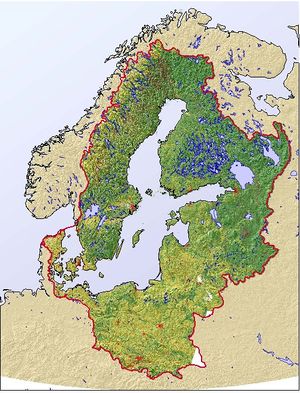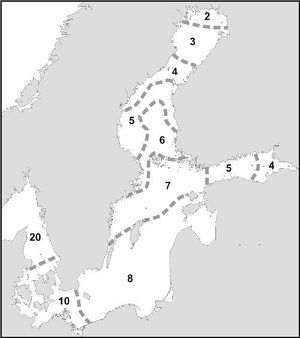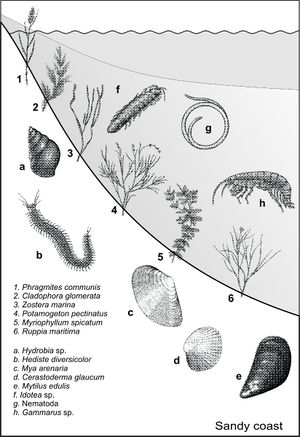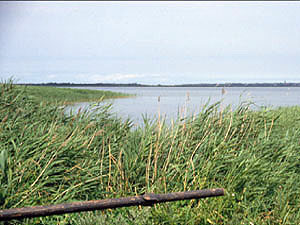Difference between revisions of "Baltic Sea"
| Line 48: | Line 48: | ||
===Coasts=== | ===Coasts=== | ||
| − | [[Image: | + | [[Image:brzeg piaszczysty.jpg|thumb|left|Figure 3: Inhabitants of sandy coasts]] |
Southern part of the Baltic Sea is fringed mainly by coasts built of sedimentary material – leftovers after glacial time. Composed mainly of sand, are vulnerable mechanical stress of wind and wave action and due to its mobility is not conducive to seaweeds and vascular plant development, also only infaunal or meibenthic animals can endure here. Coastline here is rather straight and exposed, only in estuaries or supports shelters for flora. | Southern part of the Baltic Sea is fringed mainly by coasts built of sedimentary material – leftovers after glacial time. Composed mainly of sand, are vulnerable mechanical stress of wind and wave action and due to its mobility is not conducive to seaweeds and vascular plant development, also only infaunal or meibenthic animals can endure here. Coastline here is rather straight and exposed, only in estuaries or supports shelters for flora. | ||
===Primary production=== | ===Primary production=== | ||
Revision as of 11:34, 25 April 2009
Contents
Local environment
Definition and basic facts

| Parameter | Measure |
|---|---|
| Area | 415 000km2 |
| Length | 1300 km |
| Width | 1200km |
| Maximum depth | 459m |
| Sill depth | 17m |
| Residence time of water | 25yr |
Stratification and circulation
Restricted connection with open seas toogether with high riverine inflow results in „piling up” of water in the whole basin – In Gulf of Bothnia water level is 36cm higher than in North Sea, in middle part of Baltic Proper by 18 and in Kattegat by 10cm. This generate strong current in Sound system. Inversely enters weaker (reughly twofold) current bearing saline (<34PSU) waters from North Sea. Such balance of fresh vs. Saline waters – characteristic for estuaries – cause permanent strong salinity gradient. At entrance – in Kattegat – salinity of surface waters is around 20PSU but in Bornholm Basin decrease to 8PSU and even lower at North and East periphery (Fig.2)
Coasts
Southern part of the Baltic Sea is fringed mainly by coasts built of sedimentary material – leftovers after glacial time. Composed mainly of sand, are vulnerable mechanical stress of wind and wave action and due to its mobility is not conducive to seaweeds and vascular plant development, also only infaunal or meibenthic animals can endure here. Coastline here is rather straight and exposed, only in estuaries or supports shelters for flora.
Primary production
Characteristic feature of primary production in Baltic Sea is its seasonality and spatial variability. Spring bloom – main pulse of new organic matter in higher latitudes starts in February March in Westernmost while in Northern part, in May. Annual primary production vary from 500 [gC*y-1 *m-2] in Danish fjords to [50 gC*y-1 *m-2] in open waters of Western part of Baltic Proper (Rydberget al. 2006 [3]) in Gulf of Gdańsk annual primary production is as high as ~200[gC*m-2y-1] (Lorentz et al. 1991[4]) and well below 100[gC*m-2y-1] in Northern part of the Sea (Kangas et al. 1993,[5]). This decreasing trend reflects both salinity and climatic gradients.
Specific biodiversity issues
The flora and fauna of the Baltic is unusual in that there are areas in which freshwater, brackish water and marine species co-exist. For example, the freshwater plant Phragmites spp. and the marine wrack Fucus spp. can be found side by side. The Baltic Sea has existed for a relatively short time period and has undergone major changes; subsequently it contains a very limited brackish-water flora and fauna. The area is characterised by low species diversity, but many individuals of each species.
Threats
Many of the marine species present are at the limit of their biogeographical distribution. The highest biodiversity is found in the southwest of the Baltic Sea. The major threats to marine biodiversity in the region are unsustainable exploitation of fisheries resources, eutrophication (enrichment from plant nutrient, reducing oxygen levels), pollution from contaminants and oil and the introduction of alien species.
References
- ↑ http://maps.grida.no/go/graphic/land_cover_baltic_sea_region_ balans
- ↑ Bonsdorff, E., C. Ronnberg & K. Arnio, 2002, Some ecological properties in relation to eutrophication in the Baltic Sea. Hydrobiologia 475/476, pp 371-377
- ↑ Rydberg. L, G. Ærtebjerg , L. Edler .2006. Fifty years of primary production measurements in the Baltic entrance region, trends and variability in relation to land-based input of nutrients. Journal of Sea Research 56, pp.1–16
- ↑ Lorenz Z, J. Nakonieczny, S. Ochocki, H.Renk. 1991. Primary Production and Chlorophyll in the Gulf of Gdansk in 1987-1988. Acta Ichtyologica Et Piscatoria Vol. XXI Supplement pp. 117-124
- ↑ Kangas, P., Alasaarela, E., Lax, H.-G., Jokela, S., C., Storgård-Envall. 1993. Seasonal variation of primary production and nutrient concentrations in the coastal waters of the Bothnian Bay and the Quark. Aqua Fennica, Vol. ( 2) . pp. 165-176
See also
- Baltic Marine Environment Protection Commission (Helsinki Convention)
- An exercise in comparing the pelagic and benthic macrofauna species diversity in Arctic, Antarctic and Baltic sites using the taxonomic distinctiveness index [1]
- Values of, and threats to, marine and coastal habitats in the southern Baltic [2]
- Shallow sandy sublittoral: the ecological treasure of the southern Baltic Sea [3]
- Daily sea surface temperatures rom the late 1800s to the early 2000s implications for biodiversity in the Baltic Sea [4]
- Application of benthic indices to assess biodiversity in the southern Baltic Sea [5]
Please note that others may also have edited the contents of this article.
|


